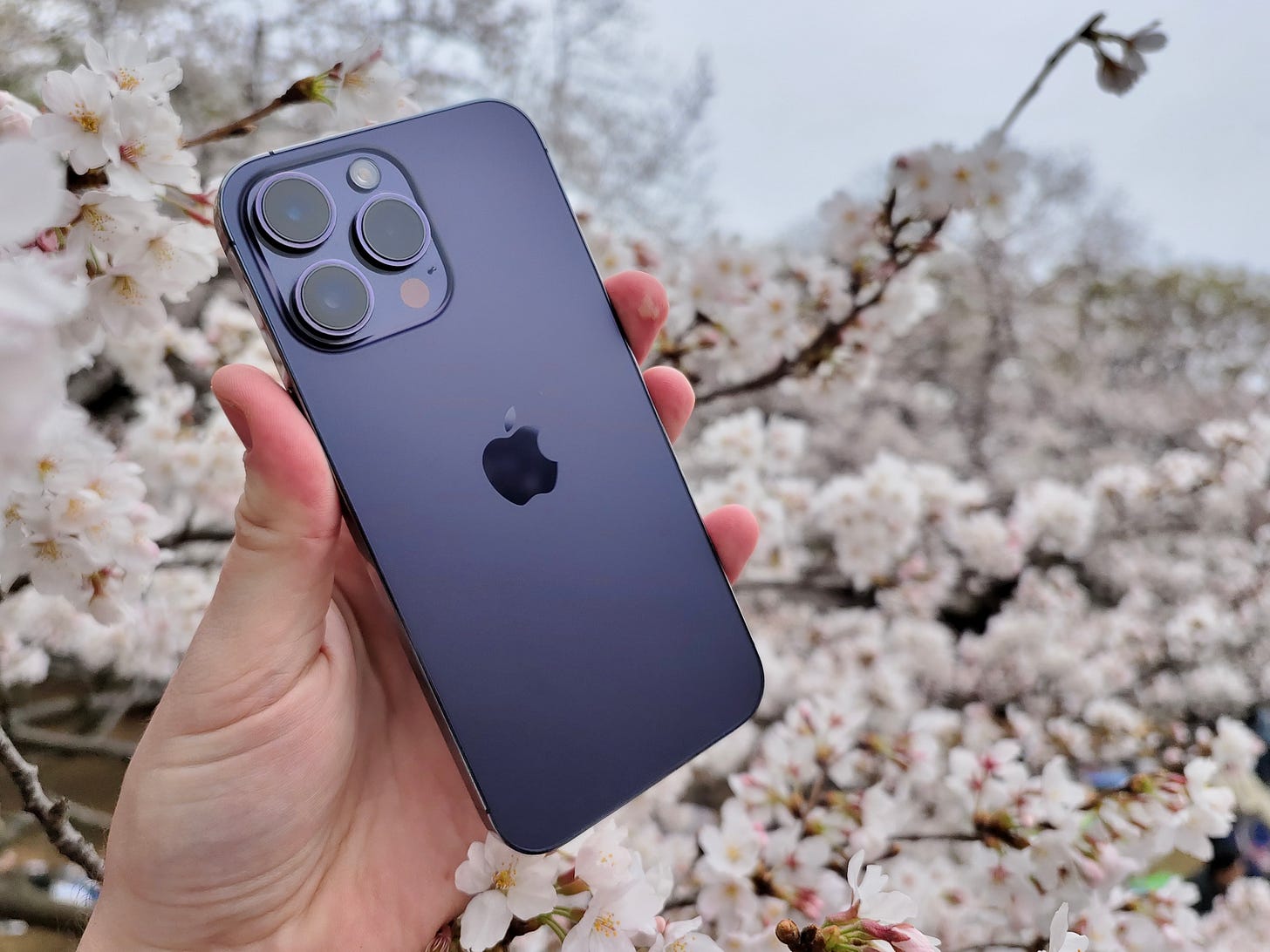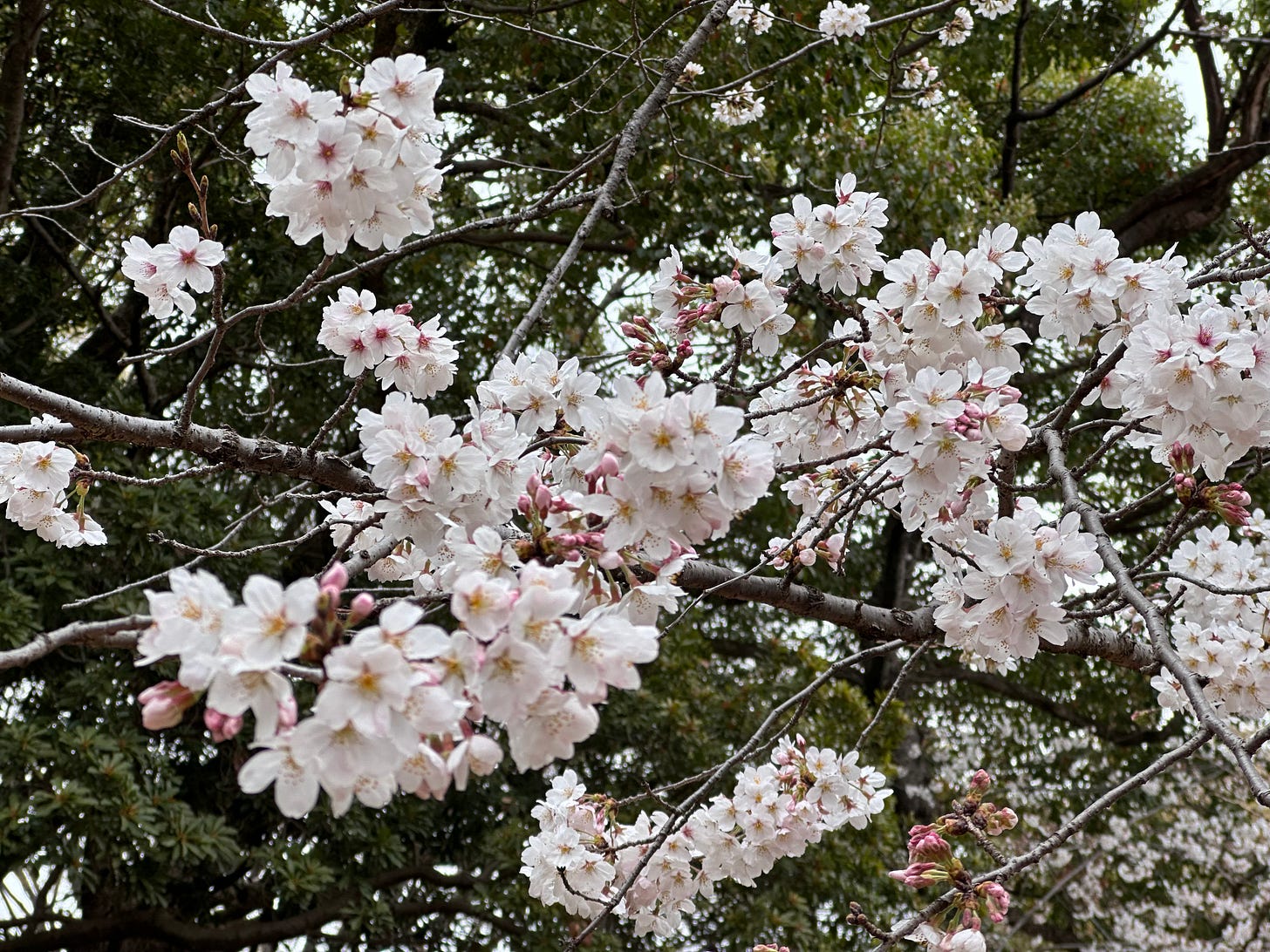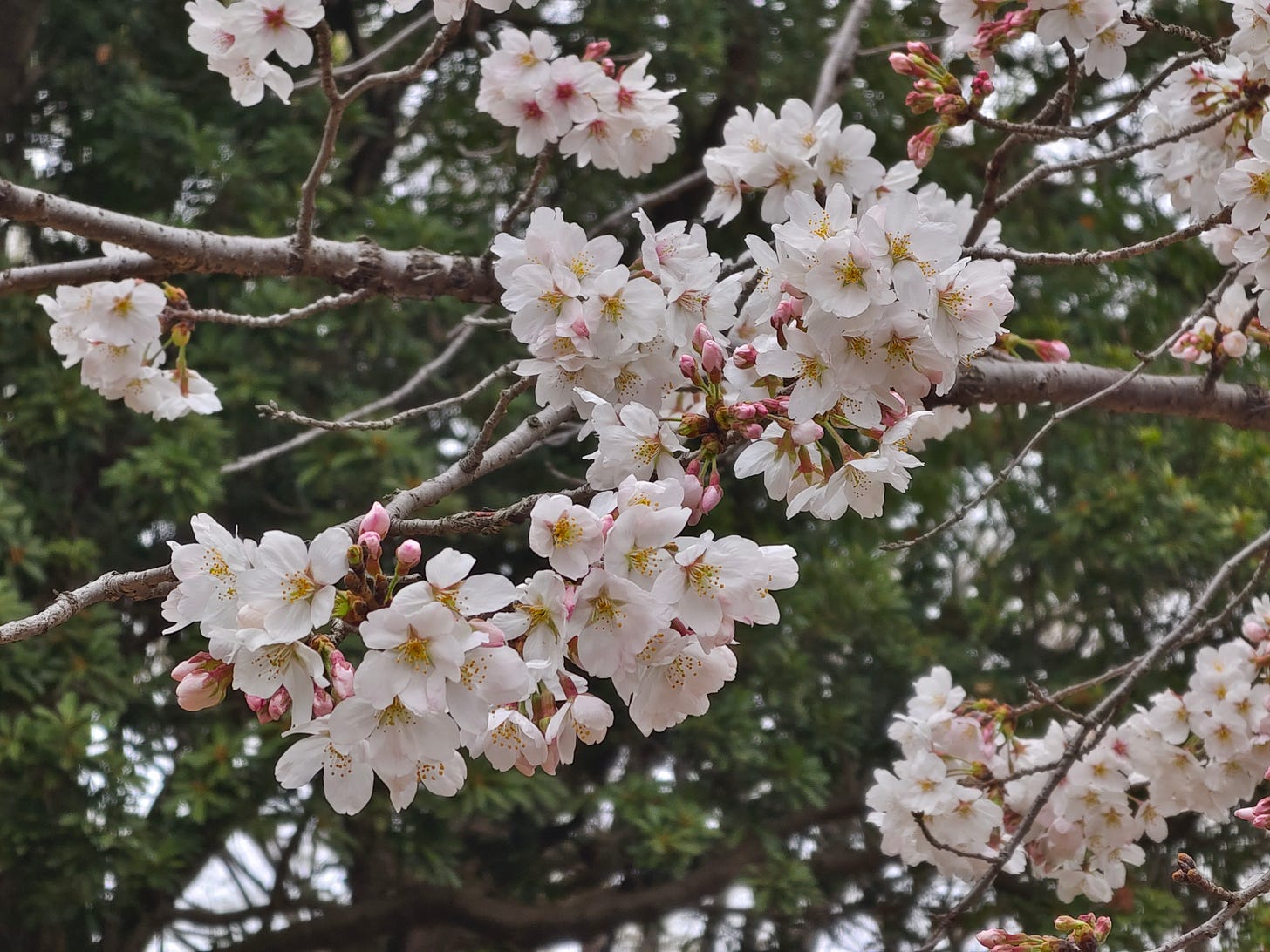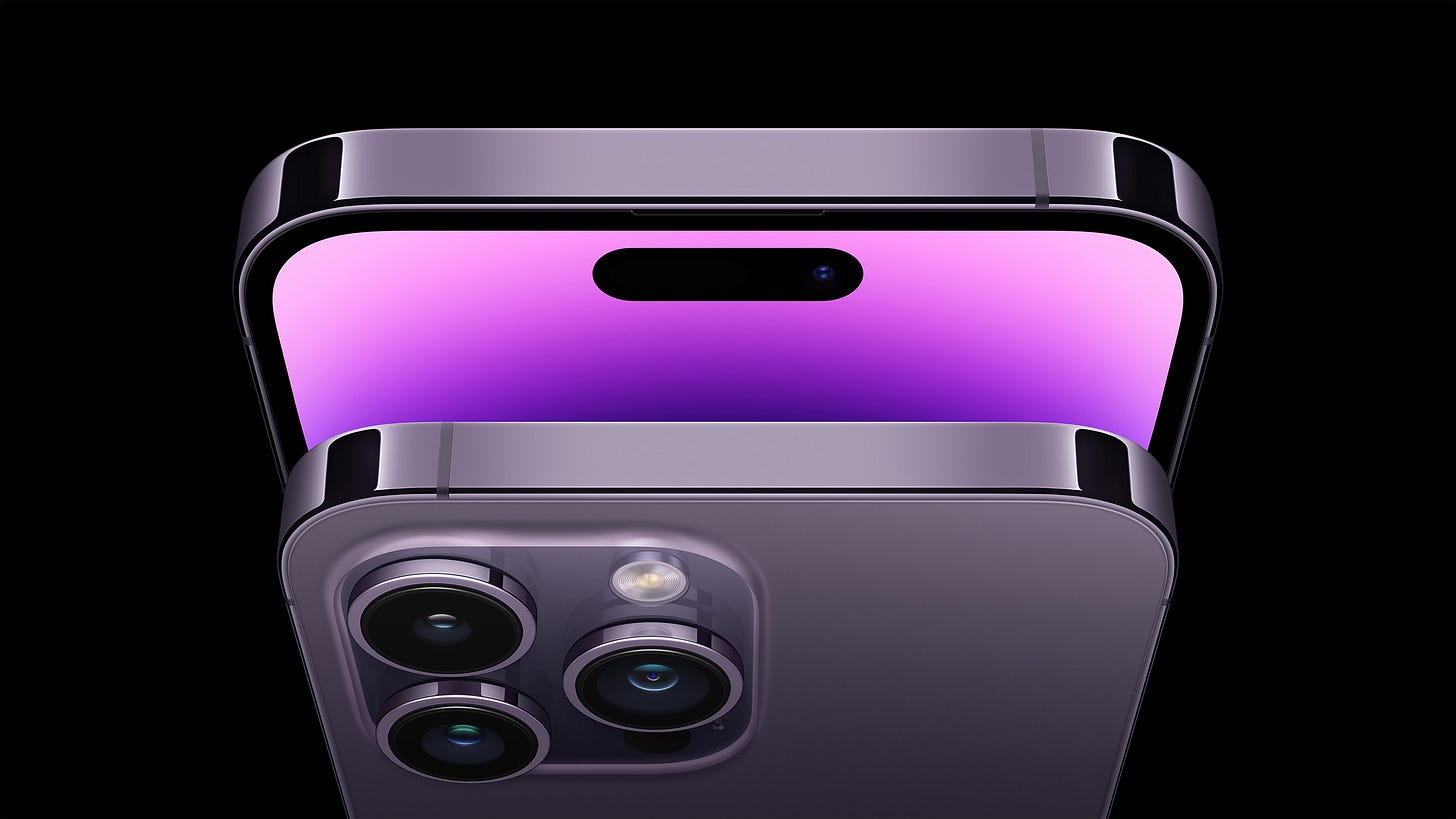iPhone 14 Pro Max: the six-month review
The best iPhone yet, but the camera is playing catch-up
Welcome back to Multicore for Tuesday, March 21st. Today is a national holiday in Japan — Vernal Equinox Day — and also quite possibly the last day many people will get to see the just-bloomed cherry blossoms this year before they get washed away by what’s looking like a week of bad weather. As such, I’m writing this issue on my iPad Pro sat under the trees on a folding camping sofa in Yoyogi Park. It’s not a bad setup.
I test dozens of phones every year, and that year's iPhone always sets the baseline. Part of that is because I live in Japan, which is so Apple-dominant that I need a personal iPhone for various mundane reasons related to everyday life. (International Android phones don’t work with the ubiquitous NFC payments/transit system, for example.) It's also a useful benchmark given that individual iPhones are consistently the most popular devices in the world.
But another thing I appreciate about the iPhone is that Apple only ever releases one high-end model a year. Compared to the Android world, where new devices come out every month, Apple sets a fixed target each September with confidence that it'll be competitive throughout the whole product cycle.
I thought it'd be worth checking in at the midway point of that cycle, as someone with a foot in the Android world as well. Most iPhone users aren't interested in switching, of course, but it's useful to understand Apple's strengths and weaknesses in the broader landscape, and six months of usage can give a better sense of the product than reviews that dropped upon launch.
Today’s issue is a long one, so it might get cut off by email clients. I’d recommend reading in your browser by clicking the headline above, or using the Substack app for iOS and Android (which is how I personally keep on top of all my subscriptions).
The iPhone 14 Pro's industrial design is basically the same as what was introduced with the iPhone 12 Pro in 2020. Anecdotally, it seems to have been somewhat divisive — it’s certainly chunky, heavy, and boxy, and that doesn't flatter the Max size in particular. Personally, I like the reassuring heft and the way the hard edges stick into my palm, but I know that's not for everyone. While most Android flagships from the past year are conventionally sleeker, there isn’t any one device I’d point to as clearly ahead on aesthetics.
I tend to go for whichever one-off colour Apple introduces each year, and the most recent one is an all-timer. "Deep Purple" may be a slightly ridiculous name, but it's my favourite iPhone finish in many years — it's subtle under subdued lighting and brilliant in broad daylight. Apple's iPhone Pro colour offerings tend to be kind of bland, and I get why it might not be practical to offer more out-there options from an inventory management perspective, but this purple is a great look that doesn't feel boring at all.
As for how the design is holding up six months in, I do have a small hairline crack near the bottom-right corner of the screen after a hard drop onto pavement. This is far from the only major fall it's taken, though, and I never use a case, so all in all I'd say it's doing okay. I haven't outright shattered an iPhone screen or back panel in recent memory.
iPhone 15 Pro schematics have leaked from the usual channels, and even though we're three years into this design, it doesn't look like a major external change is coming this year. The 15 Pro is rumoured to be using titanium instead of stainless steel, though, which should allow for a lighter device. There’s also the expected shift to “virtual” power and volume buttons.
I have no complaints at all with the display. Recent Android phones like the Galaxy S23 Ultra and the Xiaomi 13 Pro are on par in terms of brightness, contrast, and colour reproduction, but Apple almost always has access to the best panels available when each phone is released and that was certainly the case with the 14 Pro. The always-on display feature is well-executed and more advanced than on any Android phone, to the point where I heard from a lot of people who initially turned it off because it felt "too on" at first.
The 14 Pro's most hyped display feature is the Dynamic Island, Apple's neat solution to making the most out of an awkward notch situation. Most Android phones these days use simple circular "hole-punch" cut-outs for their selfie cameras, with fingerprint readers integrated under the display. Apple, on the other hand, relied on an obtrusive notch to house its selfie camera alongside the larger array of sensors it uses for its Face ID biometric authentication system.
With the 14 Pro, Apple managed to shrink the Face ID tech down to a small pill-shaped cutout alongside a regular selfie camera, then combined the two into a single lozenge that can expand and contract to show secondary information like timers, audio playback, AirPods connections, and so on. It's honestly a brilliant example of design jujutsu, turning a limitation of the hardware into software that makes the phone more useful and engaging to interact with.
That said, the level of third-party adoption is not where I expected it to be at this point. I've been using an app called Sports Alerts to track games in the background, which has worked pretty well, but the NBA's official app only got on board last week. Food delivery service Wolt quickly added support, but Uber Eats hasn't yet.
Still, it works well at a system level — things like podcast apps work automatically without the developer needing to do anything because they already use Apple's audio playback API and the Dynamic Island knows what to do. It's not revolutionary, but it's a huge improvement on the notch and is exactly the kind of fun power-user feature that Apple made its name on. I'm not sure I'd want it to go away even if it were possible to put Face ID and the selfie camera under the screen without compromise.
One area where I do think the iPhone has fallen behind is the camera system. Even compared to Android phones from last year, the 14 Pro hardware is just not all that competitive in terms of versatility and capability.
This is the first year Apple moved to a 48-megapixel sensor, which by default combines four pixels into one for a 12-megapixel image. Android phones were doing this more than four years ago and there’s nothing particularly novel in how Apple has attempted to catch up here. Those 48-megapixel sensors were physically larger than Apple’s in 2019, and the same is true today with companies like Xiaomi offering 1-inch sensors that rival enthusiast-level compact cameras. The difference is immediately noticeable in basic snapshots.
Here’s a 14 Pro Max shot of a pretty good veggieburger:
Here’s the same burger on the Xiaomi 13 Pro:
Detail levels are about the same, but the iPhone is a little noisier and the shallower depth of field and stronger contrast from the Xiaomi makes it look much more like what you’d get out of a dedicated camera. The iPhone shot is flat by comparison and doesn’t draw your eye to the subject as much.
The telephoto camera lags in terms of reach and quality. The 5x or 10x periscope telephoto designs used by many Android phone makers do have limitations in terms of sensor size and aperture, but that's true of Apple's 3x telephotos too, and the periscope approach really expands the type of photos you can take with a phone.
Here's a cherry blossom shot I took today on the 14 Pro Max:
I wanted to isolate the background as much as possible, but I couldn't focus on the flowers closest to me, and the result is kind of a mess.
Here's a shot of the same flowers on last year's Vivo X80 Pro, which has a 5x telephoto (as well as a 2x, so you still have more flexibility at normal distances):
It's just a much better photo, with clear detail and natural, shallow depth of field.
The iPhone 15 Pro Max is getting a periscope lens this year, according to analyst Ming-chi Kuo, and it's about time. Again, cameras like this have been common on Android phones for four years now.
Apple used to have a clear advantage over Android phones when it came to image processing, consistently turning out the best exposures in various situations. I wouldn’t say that it’s behind from a technical perspective today, but competitors have caught up to the point where a preference for one or the other is subjective. By default, Apple turns out flat, low-contrast images that preserve a lot of shadow and highlight detail. This gives more flexibility for editing but is rarely what I’d want the picture to look like.
That said, Apple’s camera UX is best in class. The app is clean and simple to use without any gimmicks. Photographic Styles is something that most users won’t ever think about but is a helpful way to tune the camera processing to your taste if, like me, you don’t like the default approach. I also really appreciate the option to shoot full-resolution ProRAW files that still benefit from Apple’s image processing and can be edited on a Mac later. You can get a ton of detail out of these shots and they still look good straight out of the camera.
Overall the iPhone 14 Pro has a capable camera system that I enjoy using, but it could be a lot better given the hardware that’s on the market. As with this year’s implementation of the 48-megapixel sensor, it isn’t an example of Apple biding its time before coming in and doing something the “right” way — it’s just straight-up years behind.
Battery life has been very good. The phone is sitting at 98% battery health after six months of almost exclusive wireless charging, and I don't think I've ever failed to make it through the day. I do carry an Anker MagSafe-compatible battery on longer trips, but I'm not sure I've ever needed to use it — it usually just ends up providing a top-up for an hour or so in a hot spring locker room. Apple continues to squeeze much longer endurance out of smaller batteries than its competitors even as its A-series processors outpace them in performance.
The reason for that, of course, is Apple’s uniquely vertical control over its software and hardware. You probably know where you stand on iOS vs Android, and there isn't much reason to use both unless you're like me and actively want to. I'm comfortable with both phone operating systems and usually give the edge to Android in terms of flexibility. But I've very much been a Mac person for the past couple of decades so I find iOS' integrations to be more generally helpful in that regard.
And that's kind of where I'm at with the iPhone 14 Pro Max. I'll always need an iPhone for several reasons, and this is easily the best one yet. I personally like the design, the performance and battery life are fantastic, and the Dynamic Island is a great new addition. I do wish that Apple was a little more ambitious with the camera hardware, though.
Okay, that was a lot of iPhone talk while I should have been contemplating the ephemeral nature of life under the cherry blossoms. Time for some news.









